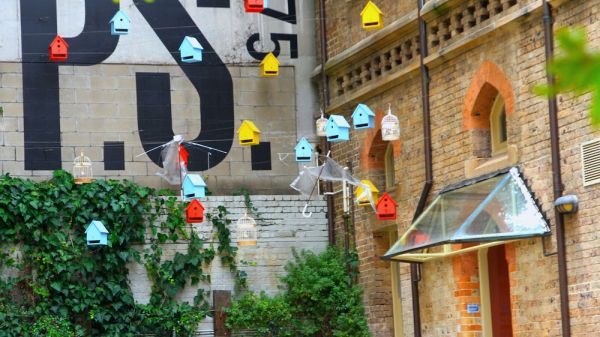School partnerships

This post is part of the “Urban EE Essays” series (April 18–June 20, 2016). Editors: Alex Russ and Marianne Krasny (Cornell University). Photo credit: Alex Russ.
School partnerships
Polly L. Knowlton Cockett, University of Calgary, Canada
Janet E. Dyment, University of Tasmania, Australia
Mariona Espinet, Universitat Autònoma de Barcelona, Spain
Yu Huang, Beijing Normal University, China
Highlights
- Urban schools can use local environments to serve as stimulus, context, and content for teaching and learning about sustainability.
- School curricula and teacher pedagogies serve to both limit and enable what is possible through urban environmental education.
- When schools establish rich and sustaining partnerships with local communities, opportunities for urban environmental education are significantly enhanced.
Introduction
Urban schools—any public, private, or charter school delivering formal primary or secondary education—are key institutions in the shaping of vibrant and sustainable cities. Imagining such cities depends on the assumptions and ideologies of those involved in the transformation of urban sites, and moving beyond perceiving urban schools as problematic institutions (Pink and Noblit, 2007). Globally, a steady process of urbanization results from migration from rural and conflict areas. This trend points to the urgent need to develop programs—including environmental education—that target schools as pivotal in serving diverse, translocated, and often marginalized students. Such urban environmental education can also empower those who live in challenging circumstances to work together to improve social-ecological well-being, and foster “citizens that are informed and motivated to live more sustainably, be responsible stewards of the environment, and help ensure future generations’ quality of life” (Alberta Council for Environmental Education, 2015).
A variety of programs that encourage student engagement in environmental initiatives have supported schools worldwide. Two foremost international initiatives are the Eco-Schools Program established in Europe in 1992, and the Green Schools Alliance introduced in the United States in 2007. They provide environmental education programs, environmental management systems, and award schemes that promote and acknowledge actions for the environment and transitioning towards sustainability. Further, United Nations Agenda 21 acknowledges local jurisdictions as being best positioned to tailor programs to the individual needs of schools and communities.
In this chapter we build on the definition of urban environmental education as “any environmental education that occurs in cities” (Russ and Krasny, 2015, p. 12), by acknowledging the importance of overarching curricular goals set by formal educational institutions. The following sections present “socioecological refrains” adapted from Knowlton Cockett (2013)—incorporating stewardship, pedagogy, interrelationships, and heritage—that highlight the role schools can play in shaping sustainable cities through the development of urban environmental education programs. These refrains promote a connectedness to place through (1) the use of the local environment to stimulate learning, (2) the development of curricula and pedagogies that embrace the development of sustainable cities, and (3) the establishment of links with the community to foster relationships, stewardship, and resiliency. Case studies from Canada, Australia, China, and Spain illustrate these refrains, as well as to show how these schools are engaged more broadly in local Green School initiatives.
Local environments as stimulus, context, and content
Creating learning environments where students can develop as citizens with pronounced understandings of sustainability is a major educational challenge. While much emphasis has been placed on incorporating sustainability into formal schooling, recent scholarship shows that significant sustainability learning can happen beyond the four corners of the classroom (Knowlton Cockett, 2013; Russ and Krasny, 2015; Tidball and Krasny, 2010). Urban “contexts” that can be used to deliver urban environmental education typically include nature centers, parks, community gardens, resource recovery centers, and landfills. Extending this diversity to other vital urban contexts such as immigrant societies, hospitals, jails, shelters, government housing, businesses, and women’s and seniors’ centers provides meaningful opportunities to partner with nearby schools for integrated urban sustainability education. Such partnerships can stimulate learners in schools to understand environmental, political, social, cultural, and economic dynamics of systems.
Through such partnerships, urban environmental education presents concrete social-ecological issues that develop student problem-solving skills, and recognizes urban communities as powerful landscapes to guide learners’ understandings, confidence, and competence in relation to sustainability. In our case studies, we present examples of students working with park managers, landscape architects, and naturalists to understand the management of invasive species to support native biodiversity. Other examples involve partnering with scientific organizations in a constructed wetland on a former coal mine site, and students studying water issues in municipal river systems. We also present a case of where a network of schools works with city administrators and universities to develop food systems and seed banks, and expand agroecology into urban settings. In each case, these urban students are working within their local social-ecological contexts.
Curriculum and pedagogy oriented towards sustainable cities
The presence of sustainability in the curriculum varies dramatically around the world: in some countries, sustainability is a stand-alone curriculum; in other countries, it features as a cross-curricular interdisciplinary area; in yet other countries, there is a notable silence in relation to sustainability (Dyment, Hill and Emery, 2014). Irrespective of curricular mandates, teachers can identify urban environments as sites for learning involving hands-on or embodied interactions within a particular place. These experiences are often framed by inquiry-based learning that position students as investigators, designers, scientists, and gardeners (Stine, 1997).
Teacher understandings of pedagogies that support learning outside the classroom is a vital factor in enabling children to use urban spaces to learn about sustainability (Skamp, 2007). Teaching in urban landscapes requires new and different pedagogies involving letting go of some control and structure afforded by inside spaces, and allowing for risk-taking with students. Potential Green School activities abound: students might utilize mathematical concepts such as perimeter or area to determine the capacity of a rooftop to harvest water into tanks. Outdoor sites such as community food gardens may provide inspiration for personal writing, artwork, or science activities. In these contexts student learning is focused towards specific features of the urban environment and may be either guided by the curriculum or the teacher, or emerge organically from the place itself.
Establishing community links to foster relationships and stewardship
School Agenda 21 and Green School programs have been developed to help urban schools collaborate with their communities and to promote socially and environmentally sustainable schools and municipalities. Despite these mainstreaming efforts, some urban schools experience challenges emerging from the collaboration (Sandäs, 2014). School Community Collaboration for Sustainable Development, a European Union funded multilateral network supported by the Environment and School Initiatives network, has undertaken an international comparative cross case study (Espinet, 2014) to investigate challenges that schools face, such as funding, effective networking, cultural background, and political orientation.
To promote sustainability, schools can adopt unconventional approaches to teaching and learning that invite community actors to cross boundaries and establish vital relationships with other actors and with their place (Wals, van der Hoeven and Blanken, 2009). For example, in our examples from China and Canada, students are also communicating their learning in the commons back to the public via websites and interpretive signage. In our case studies from Australia and Spain, several nearby schools developed networks to obtain shared funding, or to have older students mentor younger students, in each case working with community partners toward a common goal.
Four case studies
Natureground and Whispering Signs in Calgary, Alberta, Canada
The Centennial Natureground, situated in an urban Kindergarten to Grade 6 school ground in Calgary, Canada, is a publicly accessible, reclaimed and reconstructed site-sustainable mini-ecosystem, featuring native plants. The plants have been rescued from natural areas undergoing urban development, directly sowed from native seeds, or planted as seedlings for the purposes of holistic education and enjoyment. The area, established by students and volunteers in 2004, is maintained through local stewardship—by classes during the academic year and community members during the summer. These volunteers keep invasive species at bay, promoting urban biodiversity and supporting pollinators such as bees, birds, and bats. Classes regularly visit the area, for curriculum-related ecological studies and as a space to read, journal, and sketch. The Natureground also features biofiltration basins, swales, and culverts to capture rainwater and snowmelt, thus reducing and filtering stormwater runoff that would otherwise carry pollutants from paved roads straight into open waterways.

Whispering Signs is a curriculum-connected project consisting of a site-specific set of interpretive signs within the Natureground and an adjacent fragment of native shortgrass prairie. Students, teachers, parents, and community members worked together over several years to produce the original art, poetry, and text for thirty-four beautiful and provocative signs for school-based and public education. Figure 1, an example of an alphabet sign, shows a common white-tailed jackrabbit changing its coat over the seasons, during a variety of weather conditions, and under different heights of the sun over the course of a year—all concepts within the school curriculum. Latitude, longitude, and elevation are indicated on each sign, and give rise to spatial geography studies and orienteering activities. These signs stem from a place-based literacy project conducted in the area, where students researched, represented, and communicated information about plants, animals, and features. Throughout these and other Green School projects, participants developed meaningful interrelationships, and became increasingly connected to place.
Constructed wetlands and frogs in Australia’s Latrobe Valley
An unusual urban environmental initiative is found in a surprising place in Australia: in the heart of the Latrobe Valley in Gippsland, Victoria. This region supplies electricity through brown coal-fired power generation. Socially and economically disadvantaged, this area has huge open cut brown coal mines, massive power lines, transformer stations, and puffing chimneys of large and small power stations. The Valley has poor air quality and high pollution levels.
However, a local primary school began using the Morwell River Wetlands as a site for teaching and learning about the complex social, cultural, economic, and environmental aspects of this contested area (Somerville and Green, 2012). The wetlands, part artificial and part natural, have been constructed in the river overflow site that was relocated to make way for the coal mine. The wetland has pools, banks, islands, and many creatures and plants, including frogs, trees, shrubs, and grasses. The primary school has been involved in the wetland since it was constructed and students have monitored the plants and animals that have found “home” there. Shortly after development, three local schools applied for a science grant and received $20,000 to set up a wetland study and develop a curriculum model. The schools worked with the Amphibian Research Centre to develop the Frog Census program based on the belief that frogs are the gateway to understanding the wetlands.
The wetlands are visited regularly by all school grades, and curriculum links are made across subject areas. Younger students study life cycles of frogs, and raise tadpoles in a mini-wetland constructed in their school ground. Middle year students monitor the wetlands; older students measure water quality and identify micro- and macro-organisms. From an eyesore to a healthy ecosystem, these constructed wetlands have become enriched with educational opportunities for local students.
“Water-loving” studies on the Long River in Beijing, China
The high school affiliated with the Beijing Institute of Technology is located on the southern bank of the Long River, which is an indispensable part of the Beijing city water system. Influenced by the Green School movement, which has been supported by the national government in China since 1996, the school has been promoting a series of local environmental education activities since 2001 (Liu and Huang, 2013). For example, in the context of general water inquiries, teachers have established “water-loving” student groups. These grade-level groups carry out many projects, such as investigating water usage in their school and households, as well as researching the watersheds surrounding their campus.

Under teachers’ guidance, members of “water-loving” groups study water issues surrounding the school and the Long River system. After preliminary investigations and analyses, students undertake Long River water surveys and launch environmental fieldwork integrating aspects of geography, biology, chemistry, and physics. As young scientists (Figure 2), the students design their research, and divide their work reasonably and rethink obstacles they encounter, while constantly discussing and revising plans with others. Teachers and students also use information technology to record and share students’ research processes and results. They use data they collect as resources for information technology courses. Then they create “water-loving” actions, such as conservation measures and water quality monitoring, on a website, which provides a convenient way to locate and express their research process or results. Thus, this project-based learning provides rich curriculum resources for information technology, and offers a medium of communication about project results and actions. These two stages of “Integrated Curriculum of Practical Activity” complement and promote each other.
Through these local activities on the Long River, the “water-loving” theme is effectively spread and sets up a series of "water-loving” actions. The activities also have been playing an important role in motivating students to explore their interests and laying a foundation for future inquiries. In addition, teachers update their own educational concepts, thus enhancing the capacity for adapting and implementing curriculum reform.
School agroecology and community collaboration, Sant Cugat del Vallès, Catalonia, Spain
The Science Education Department at the Autonomous University of Barcelona and the City Hall Environment Department of the Sant Cugat del Vallès municipality in Catalonia, Spain collaborated for seven years to enhance the School Agenda 21 program in the city. Established in 2001, the program involved urban schools in the city’s effort to promote sustainable development, and established links between schools and the community for the development of School Agroecology (Llerena, 2015), a newly created educational field. The program built an urban school network involving all public urban schools from pre-K to secondary level, university researchers, local administrators, and environmental educators with the aim to empower students, teachers, and the community to develop agroecological food production and food consumption (Espinet and Llerena, 2014).

One of the collective projects was to transform school and community food gardens as places to grow endangered native plants (Figure 3). After consultation with a regional seed bank, each school chose a specific native plant to grow; students then harvested and preserved seeds, and shared seeds among different school and community actors to be grown in their own food gardens. Through a service-learning approach, secondary students visited primary students to teach seed preservation. Seed exchanges became an event where donor schools provided not only a sample of seeds but also storytelling, drama, or visualizations about growing practices. Once schools started having seeds from several plants, they built seed banks inside their schools. In so doing, urban public schools with the help of the community became authentic urban agents of native plant preservation. One results of this urban environmental education innovation project has been the creation of a new professional niche: the agro-environmental educator responsible for promoting and maintaining urban environmental education activities on the food system at the interface between the school and the city.
Conclusion
As demonstrated by our urban case studies, ongoing Green School actions—whether learning about lifecycles, monitoring water quality, or seed harvesting— guide students in new approaches to understanding their environment. Within the complex networks of urban settings, students also become directly engaged in urgent and interrelated global movements, for example related to food security, as well as global initiatives such as Local Action for Biodiversity or BiodiverCities. Thus, social-ecological refrains, involving place-based, curriculum-connected, community-engaged, collaborative practices, serve as effective frameworks for urban primary and secondary schools to provide students with rich, meaningful experiential learning opportunities fostering systems-thinking, stewardship, and sustainability.
References
- Alberta Council for Environmental Education. (2015). Mission and vision. Canmore, Canada: ACEE.
- Dyment, J.E., Hill, A., and Emery, S. (2014). Sustainability as a cross-curricular priority in the Australian curriculum: A Tasmanian investigation. Environmental Education Research, 21(8) 1105-1126.
- Espinet, M., and Llerena, G. (2014). School agroecology as a motor for community and land transformation: A case study on the collaboration among community actors to promote education for sustainability networks. In Constantinou, C.P., Papadouris, N., and Hadjigeorgiou, A. (Eds.). Proceedings of the ESERA 2013 Conference: Science Education Research For Evidence-based Teaching and Coherence in Learning (p. 244-50). Nicosia, Cyprus: ESERA.
- Espinet, M. (Ed.). (2014). CoDeS selected cases of school community collaboration for sustainable development. Vienna, Austria: Austrian Federal Ministry of Education and Women’s Affairs.
- Knowlton Cockett, P. (2013). In situ conversation: Understanding sense of place through socioecological cartographies. Doctoral dissertation, University of Calgary, Canada.
- Liu, J. and Huang, Y. (2013). Practices and inspirations on a school-based curriculum for ESD. Research on Curriculum, Textbook and Teaching Method, 33(3), 98-102. (In Chinese.)
- Llerena, G. (2015). Agroecologia escolar. Doctoral dissertation, Universitat Autònoma de Barcelona, Bellaterra, Spain.
- Pink, W.T. and Noblit, G.W. (Eds.). (2007). International handbook of urban education. Dordrecht, The Netherlands: Springer.
- Russ, A. and Krasny, M. (2015). Urban environmental education trends. In Russ, A. (Ed.). Urban environmental education (pp. 12-25). Ithaca, New York and Washington, DC: Cornell University Civic Ecology Lab, NAAEE and EECapacity.
- Sandäs, A. (2014). Travelling through the landscape of school-community collaboration for sustainable development. In Affolter, C. and Reti, M. (Eds.). Travelling guide for school community collaboration for sustainable development. ENSI i.n.p.a:. CoDeS Network.
- Skamp, K. (2007). Understanding teachers’ “levels of use” of learnscapes. Environmental Education Research, 15(1), 93-110.
- Somerville, M., and Green, M. (2012). Place and sustainability literacy in schools and teacher education. Paper presented at Australian Association for Research in Education, Sydney, Australia.
- Stine, S. (1997). Landscapes for learning: Creating outdoor environments for children and youth. Toronto: John Wiley & Sons.
- Tidball, K.G. and Krasny, M.E. (2010). Urban environmental education from a social-ecological perspective: conceptual framework for civic ecology education. Cities and the Environment, 3(1): article 11.
- Wals, A., van der Hoeven, N., and Blanken, H. (2009). The acoustics of social learning: Designing learning processes that contribute to a more sustainable world. Utrecht, The Netherlands: Wageningen Academic Publishers.



